light TOYOTA C-HR 2020 Warranties & Maintenance Guides (in English)
[x] Cancel search | Manufacturer: TOYOTA, Model Year: 2020, Model line: C-HR, Model: TOYOTA C-HR 2020Pages: 260, PDF Size: 8.54 MB
Page 228 of 260
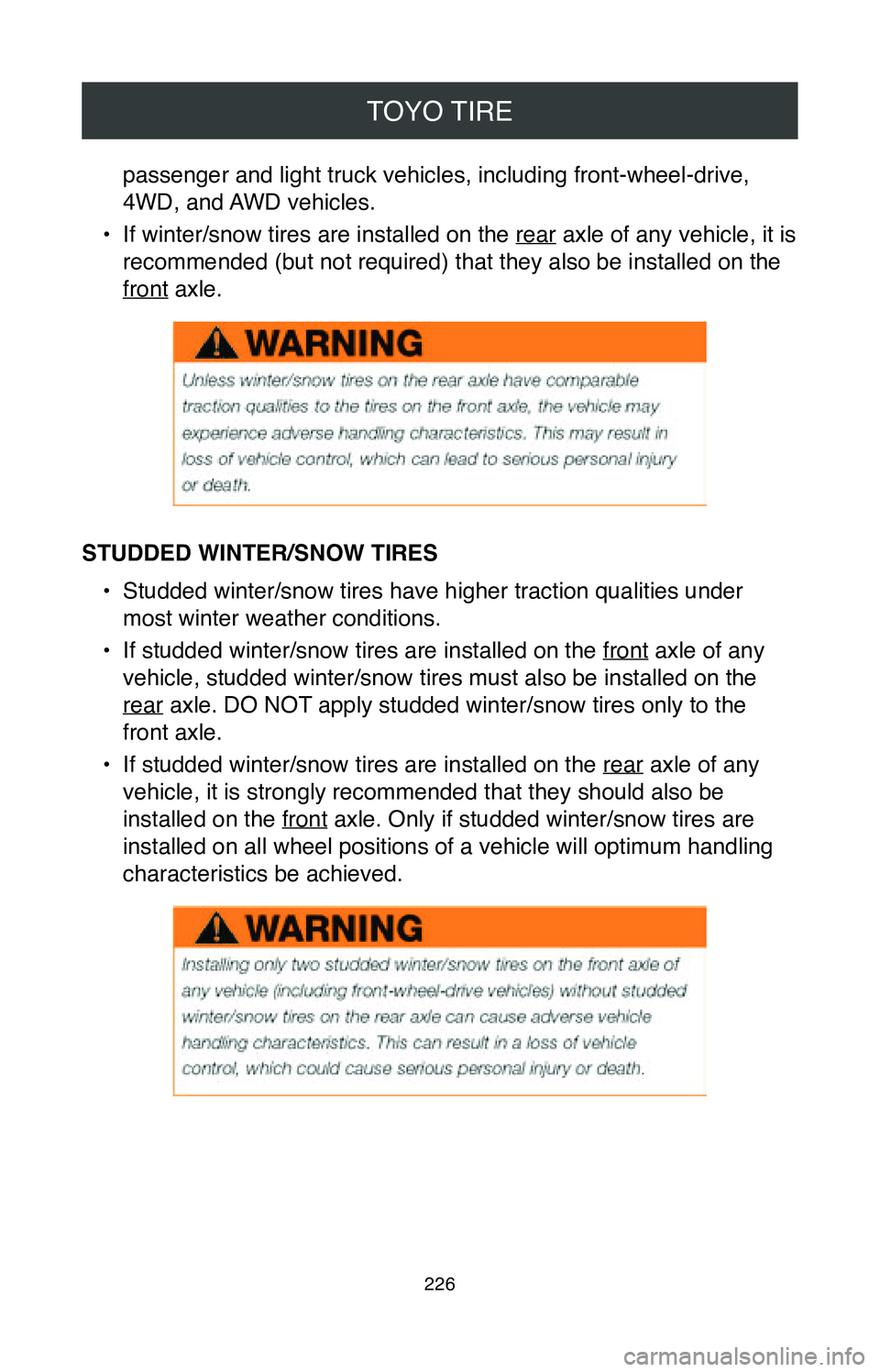
TOYO TIRE
226
passenger and light truck vehicles, including front-wheel-drive,
4WD, and AWD vehicles.
•
If winter/snow tires are installed on the rear axle of any vehicle, it is
recommended (but not required) that they also be installed on the
front axle.
STUDDED WINTER/SNOW TIRES
•
Studded winter/snow tires have higher traction qualities under
most winter weather conditions.
•
If studded winter/snow tires are installed on the front axle of any
vehicle, studded winter/snow tires must also be installed on the
rear axle. DO NOT apply studded winter/snow tires only to the
front axle.
•
If studded winter/snow tires are installed on the rear axle of any
vehicle, it is strongly recommended that they should also be
installed on the front axle. Only if studded winter/snow tires are
installed on all wheel positions of a vehicle will optimum handling
characteristics be achieved.
Page 231 of 260

TOYO TIRE
229
If you experience a blowout or a sudden tire failure, the following
information should be helpful:•
When the tire failure occurs, you may hear a loud noise, or feel a
vibration, and/or the vehicle may pull toward the side of the failed
tire. Do not abruptly brake or turn.
•
Maintain steady pressure on the accelerator pedal.
•
Hold the steering wheel firmly and steer to maintain your
lane position.
•
Find a safe place to pull off the road and allow the vehicle to
gradually decelerate. Apply light braking as required to stop safely.
•
Gradually pull over to the shoulder and come to a stop. Look for a
damaged tire on your vehicle.
•
Seek roadside assistance or change the damaged tire with your
spare tire.
•
Have all of your tires and the vehicle thoroughly inspected by a
tire professional.
TIRE ROTATION
The purpose for rotating tires is to achieve more uniform wear for all
tires on a vehicle. Your tires should be thoroughly examined on a lift by
a tire dealer for any abnormalities. If tires show uneven treadwear, ask
the service person to check and/or correct any vehicle wheel alignment
or other mechanical problem before rotation.
The following rotation patterns are acceptable. Please refer to your
vehicle Owner’s Manual for rotation advice.
Page 232 of 260
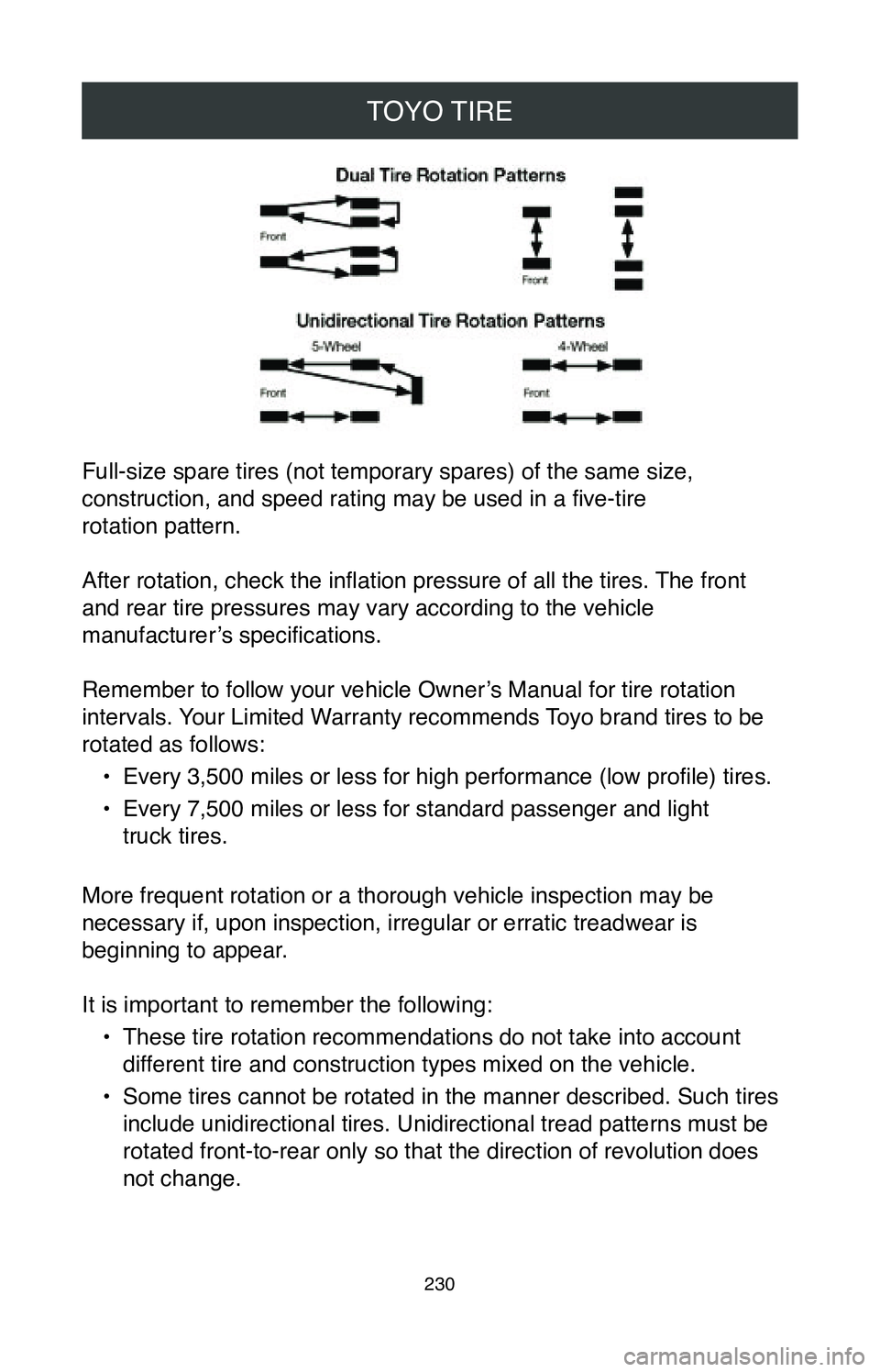
TOYO TIRE
230
Full-size spare tires (not temporary spares) of the same size,
construction, and speed rating may be used in a five-tire
rotation pattern.
After rotation, check the inflation pressure of all the tires. The front
and rear tire pressures may vary according to the vehicle
manufacturer’s specifications.
Remember to follow your vehicle Owner’s Manual for tire rotation
intervals. Your Limited Warranty recommends Toyo brand tires to be
rotated as follows:
•
Every 3,500 miles or less for high performance (low profile) tires.
•
Every 7,500 miles or less for standard passenger and light
truck tires.
More frequent rotation or a thorough vehicle inspection may be
necessary if, upon inspection, irregular or erratic treadwear is
beginning to appear.
It is important to remember the following: •
These tire rotation recommendations do not take into account
different tire and construction types mixed on the vehicle.
•
Some tires cannot be rotated in the manner described. Such tires
include unidirectional tires. Unidirectional tread patterns must be
rotated front-to-rear only so that the direction of revolution does
not change.
Page 233 of 260
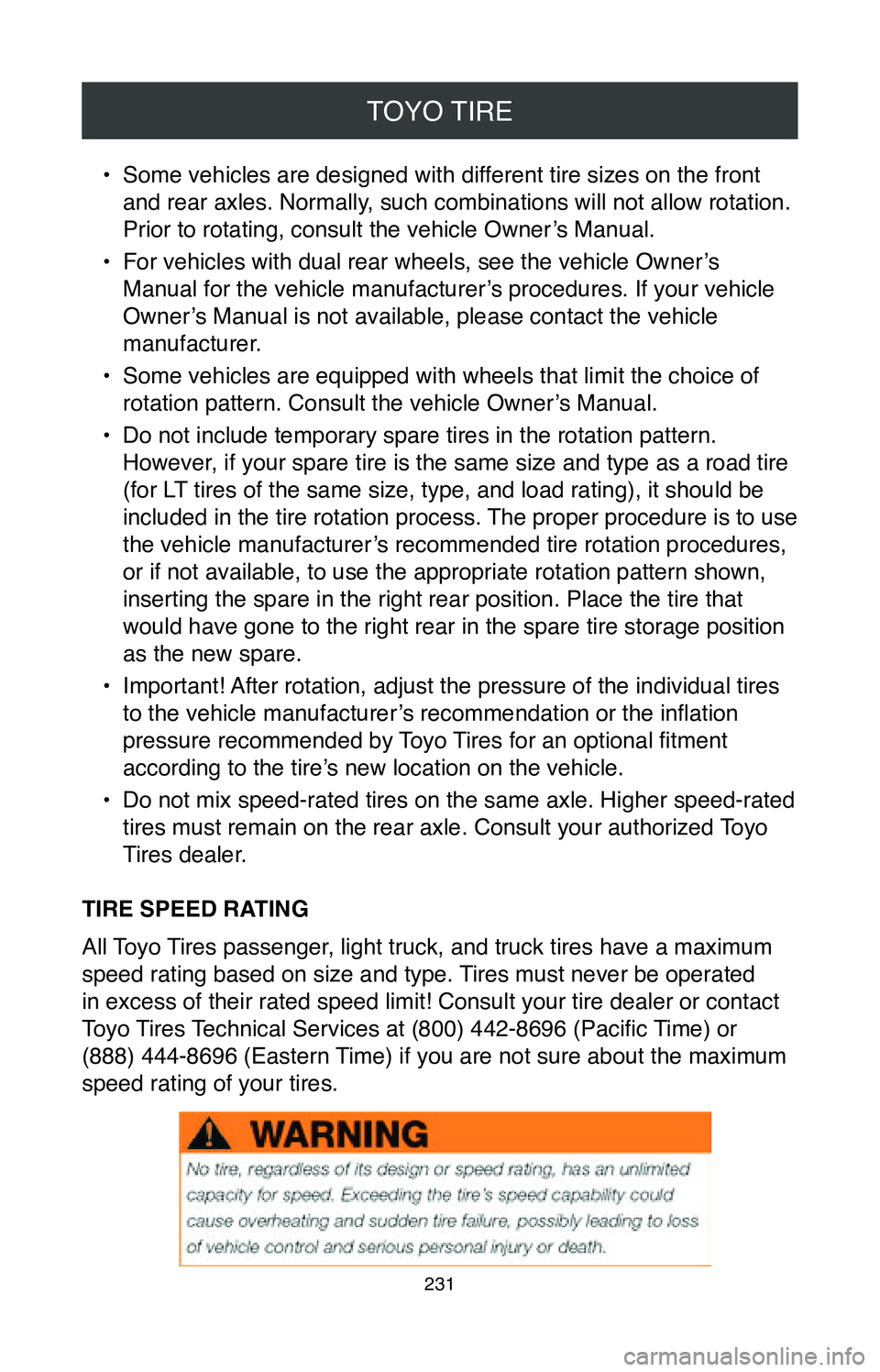
TOYO TIRE
231
• Some vehicles are designed with different tire sizes on the front
and rear axles. Normally, such combinations will not allow rotation.
Prior to rotating, consult the vehicle Owner’s Manual.
•
For vehicles with dual rear wheels, see the vehicle Owner’s
Manual for the vehicle manufacturer’s procedures. If your vehicle
Owner’s Manual is not available, please contact the vehicle
manufacturer.
•
Some vehicles are equipped with wheels that limit the choice of
rotation pattern. Consult the vehicle Owner’s Manual.
•
Do not include temporary spare tires in the rotation pattern.
However, if your spare tire is the same size and type as a road tire
(for LT tires of the same size, type, and load rating), it should be
included in the tire rotation process. The proper procedure is to use
the vehicle manufacturer’s recommended tire rotation procedures,
or if not available, to use the appropriate rotation pattern shown,
inserting the spare in the right rear position. Place the tire that
would have gone to the right rear in the spare tire storage position
as the new spare.
•
Important! After rotation, adjust the pressure of the individual tires
to the vehicle manufacturer’s recommendation or the inflation
pressure recommended by Toyo Tires for an optional fitment
according to the tire’s new location on the vehicle.
•
Do not mix speed-rated tires on the same axle. Higher speed-rated
tires must remain on the rear axle. Consult your authorized Toyo
Tires dealer.
TIRE SPEED RATING
All Toyo Tires passenger, light truck, and truck tires have a maximum
speed rating based on size and type. Tires must never be operated
in excess of their rated speed limit! Consult your tire dealer or contac\
t
Toyo Tires Technical Services at (800) 442-8696 (Pacific Time) or
(888) 444-8696 (Eastern Time) if you are not sure about the maximum
speed rating of your tires.
Page 240 of 260
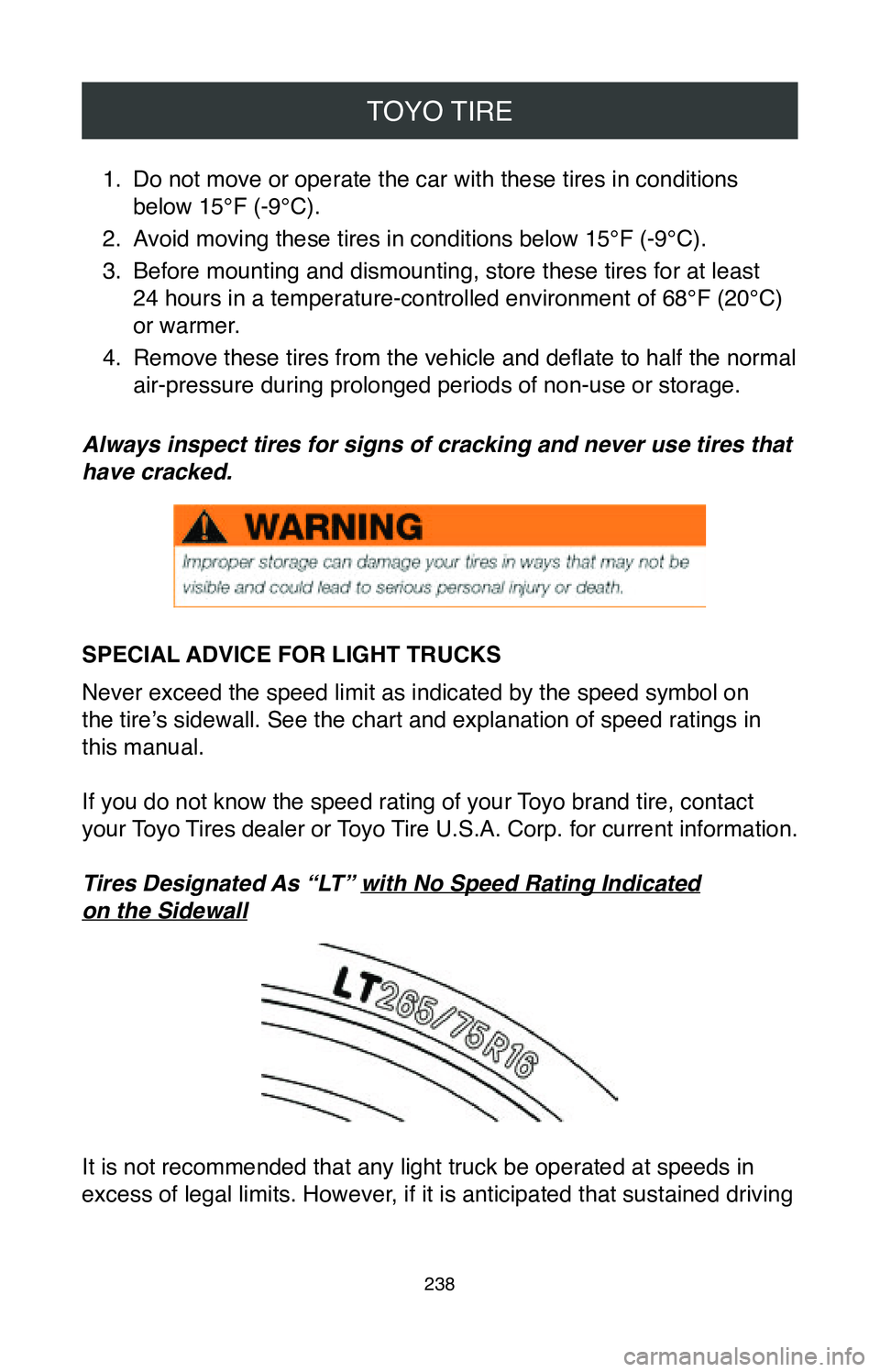
TOYO TIRE
238
1. Do not move or operate the car with these tires in conditions
below 15°F (-9°C).
2.
Avoid moving these tires in conditions below 15°F (-9°C).
3.
Before mounting and dismounting, store these tires for at least
24 hours in a temperature-controlled environment of 68°F (20°C)
or warmer.
4.
Remove these tires from the vehicle and deflate to half the normal
air-pressure during prolonged periods of non-use or storage.
Always inspect tires for signs of cracking and never use tires that
have cracked.
SPECIAL ADVICE FOR LIGHT TRUCKS
Never exceed the speed limit as indicated by the speed symbol on
the tire’s sidewall. See the chart and explanation of speed ratings in
this manual.
If you do not know the speed rating of your Toyo brand tire, contact
your Toyo Tires dealer or Toyo Tire U.S.A. Corp. for current information.
Tires Designated As “LT” with No Speed Rating Indicated
on the Sidewall
It is not recommended that any light truck be operated at speeds in
excess of legal limits. However, if it is anticipated that sustained driving
Page 241 of 260
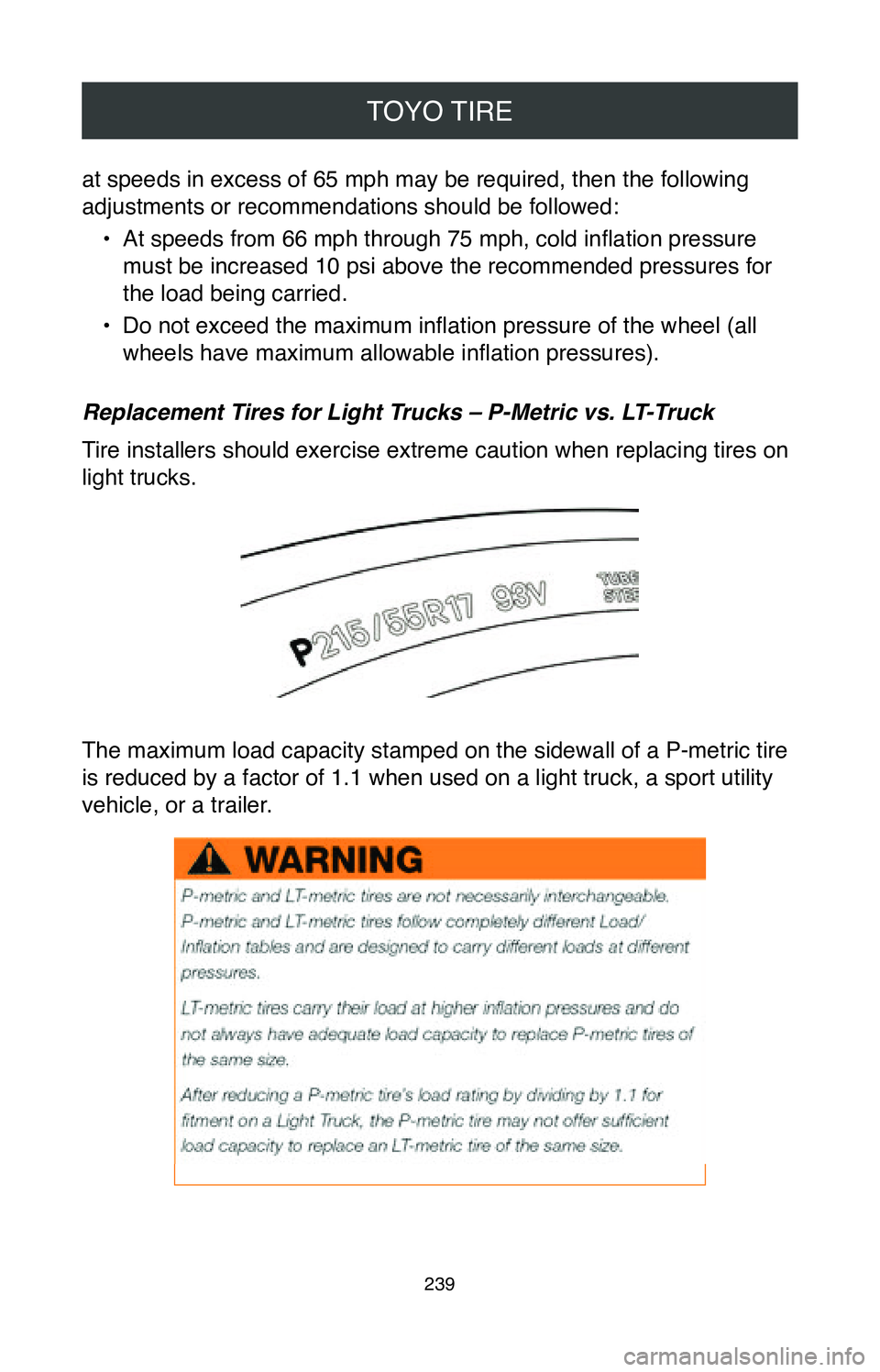
TOYO TIRE
239
at speeds in excess of 65 mph may be required, then the following
adjustments or recommendations should be followed:•
At speeds from 66 mph through 75 mph, cold inflation pressure
must be increased 10 psi above the recommended pressures for
the load being carried.
•
Do not exceed the maximum inflation pressure of the wheel (all
wheels have maximum allowable inflation pressures).
Replacement Tires for Light Trucks – P-Metric vs. LT-Truck
Tire installers should exercise extreme caution when replacing tires on
light trucks.
The maximum load capacity stamped on the sidewall of a P-metric tire
is reduced by a factor of 1.1 when used on a light truck, a sport utilit\
y
vehicle, or a trailer.
Page 242 of 260
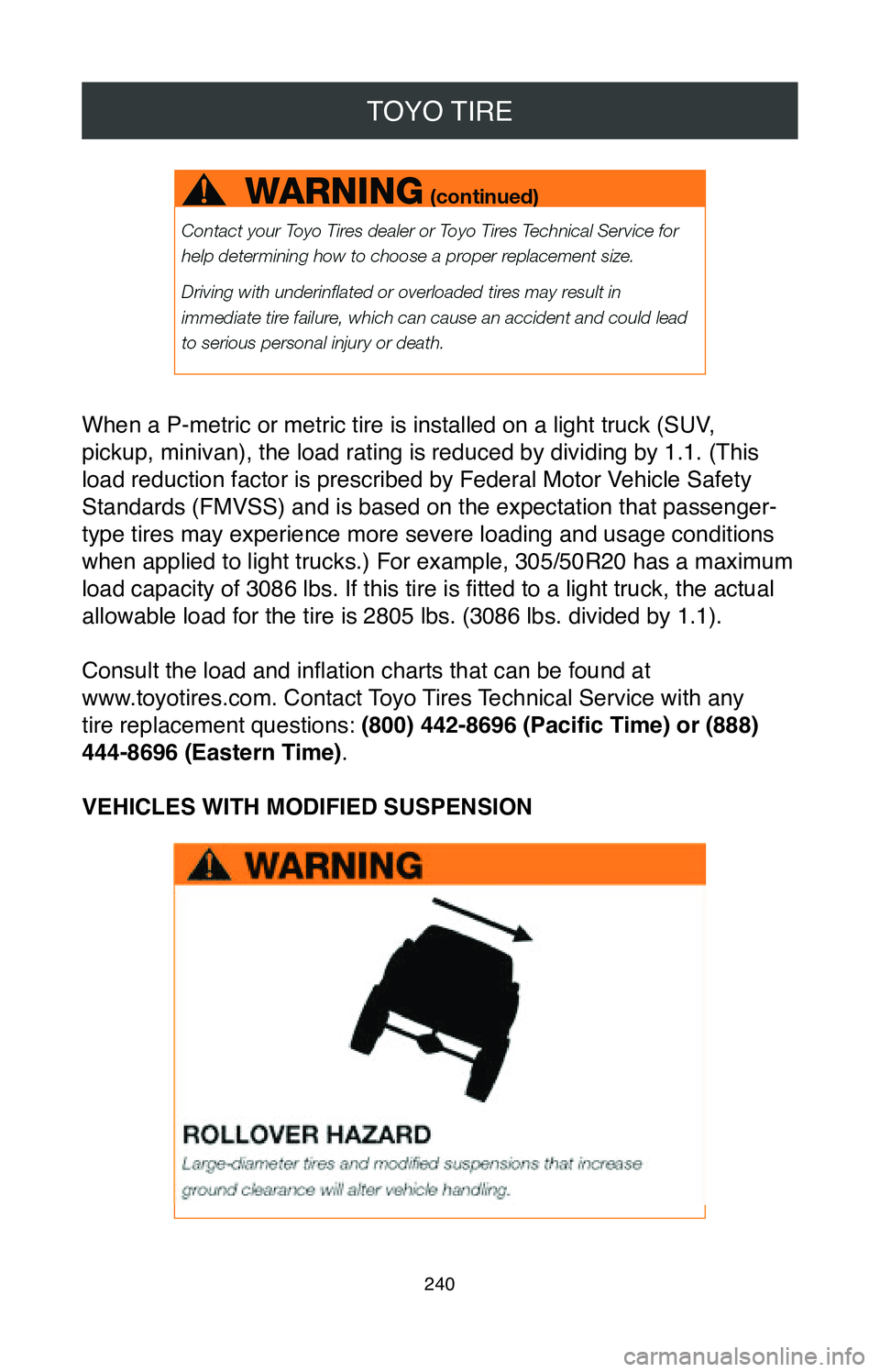
TOYO TIRE
240
When a P-metric or metric tire is installed on a light truck (SUV,
pickup, minivan), the load rating is reduced by dividing by 1.1. (This
load reduction factor is prescribed by Federal Motor Vehicle Safety
Standards (FMVSS) and is based on the expectation that passenger-
type tires may experience more severe loading and usage conditions
when applied to light trucks.) For example, 305/50R20 has a maximum
load capacity of 3086 lbs. If this tire is fitted to a light truck, the actual
allowable load for the tire is 2805 lbs. (3086 lbs. divided by 1.1).
Consult the load and inflation charts that can be found at
www.toyotires.com. Contact Toyo Tires Technical Service with any
tire replacement questions: (800) 442
-8696 (Pacific Time) or (888)
444
-8696 (Eastern Time).
VEHICLES WITH MODIFIED SUSPENSION
Page 243 of 260
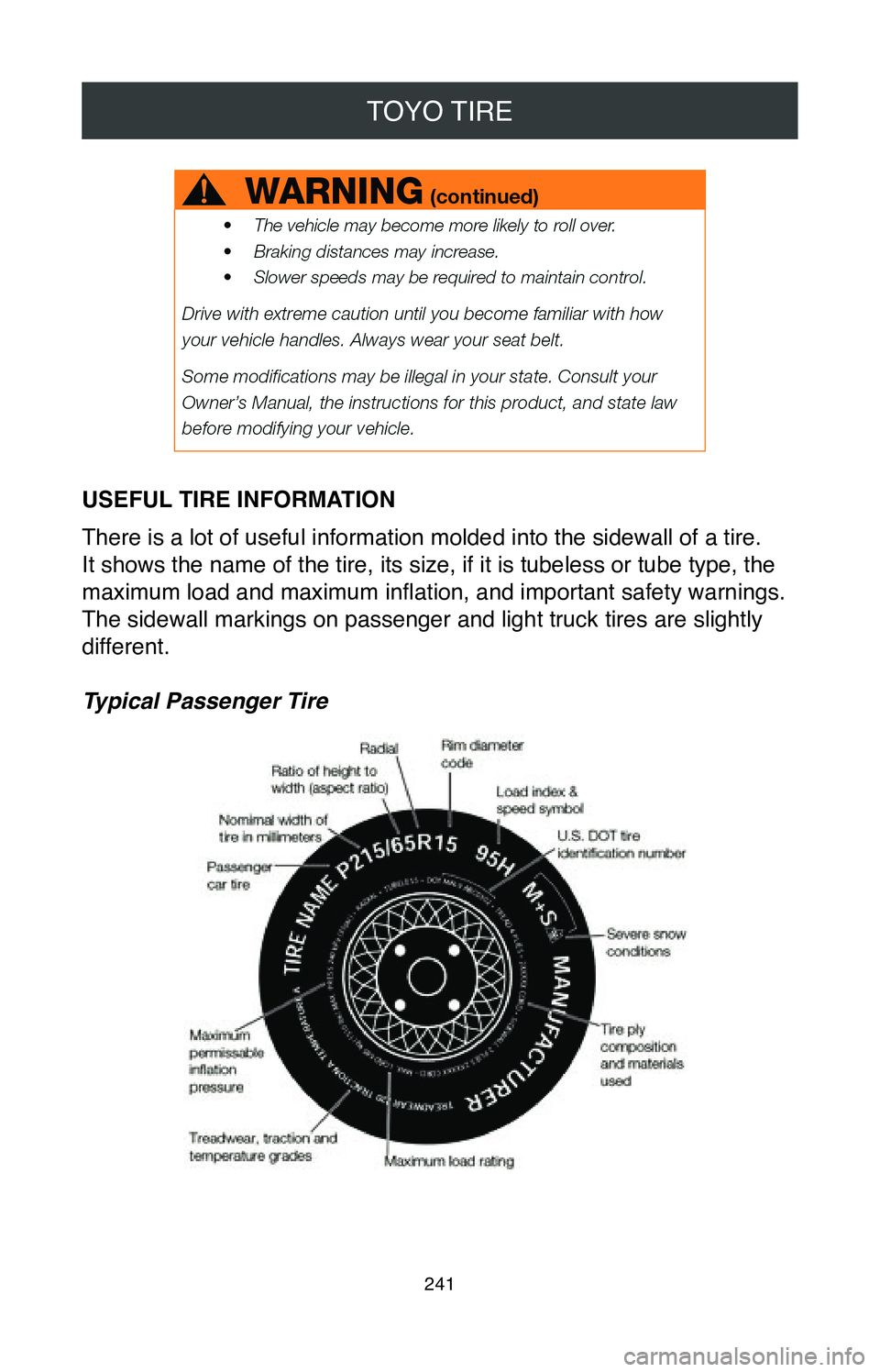
TOYO TIRE
241
USEFUL TIRE INFORMATION
There is a lot of useful information molded into the sidewall of a tire.\
It shows the name of the tire, its size, if it is tubeless or tube type,\
the
maximum load and maximum inflation, and important safety warnings.
The sidewall markings on passenger and light truck tires are slightly
different.
Typical Passenger Tire
Page 244 of 260
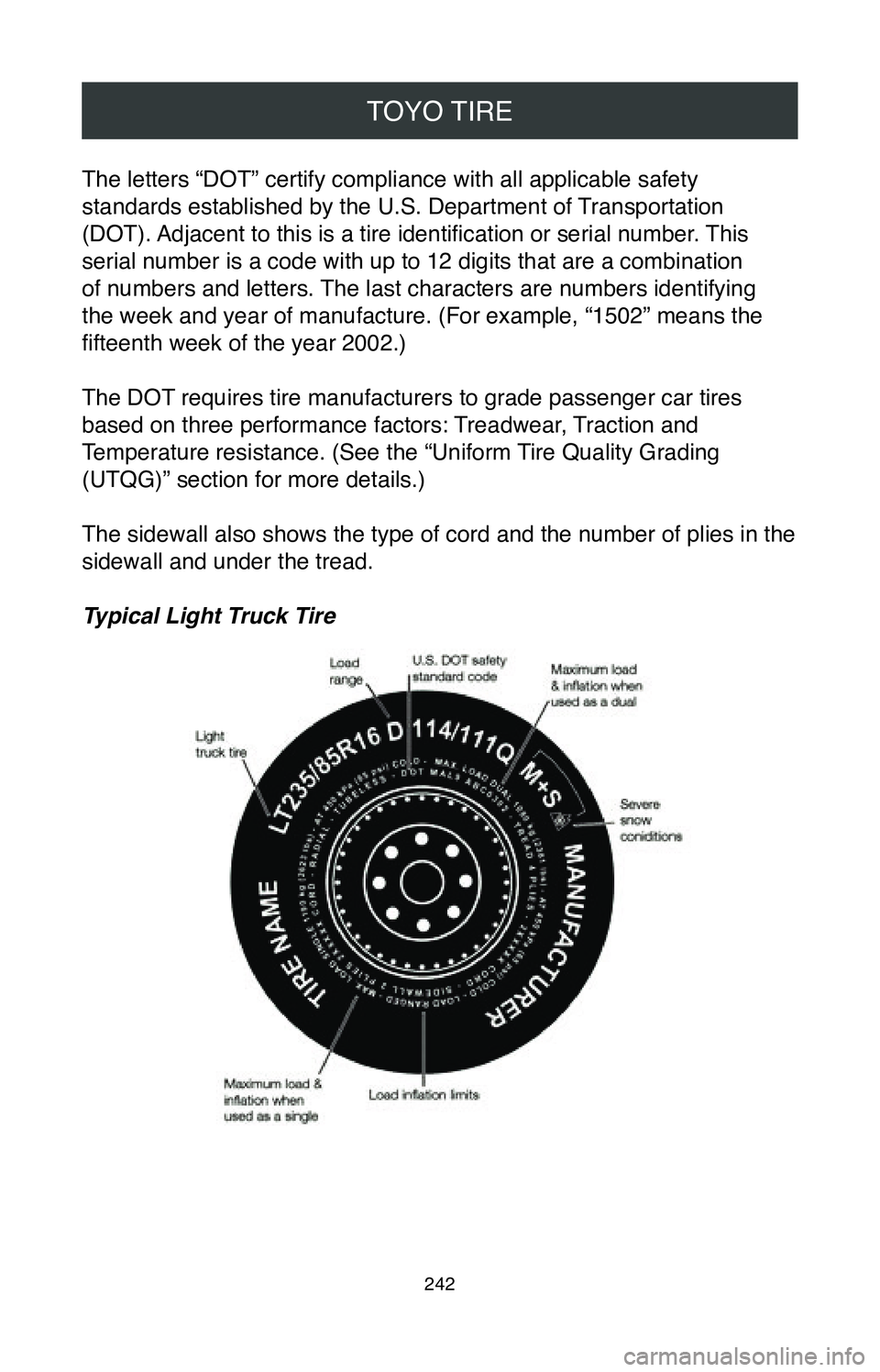
TOYO TIRE
242
The letters “DOT” certify compliance with all applicable safety
standards established by the U.S. Department of Transportation
(DOT). Adjacent to this is a tire identification or serial number. This
serial number is a code with up to 12 digits that are a combination
of numbers and letters. The last characters are numbers identifying
the week and year of manufacture. (For example, “1502” means the
fifteenth week of the year 2002.)
The DOT requires tire manufacturers to grade passenger car tires
based on three performance factors: Treadwear, Traction and
Temperature resistance. (See the “Uniform Tire Quality Grading
(UTQG)” section for more details.)
The sidewall also shows the type of cord and the number of plies in the \
sidewall and under the tread.
Typical Light Truck Tire
Page 248 of 260
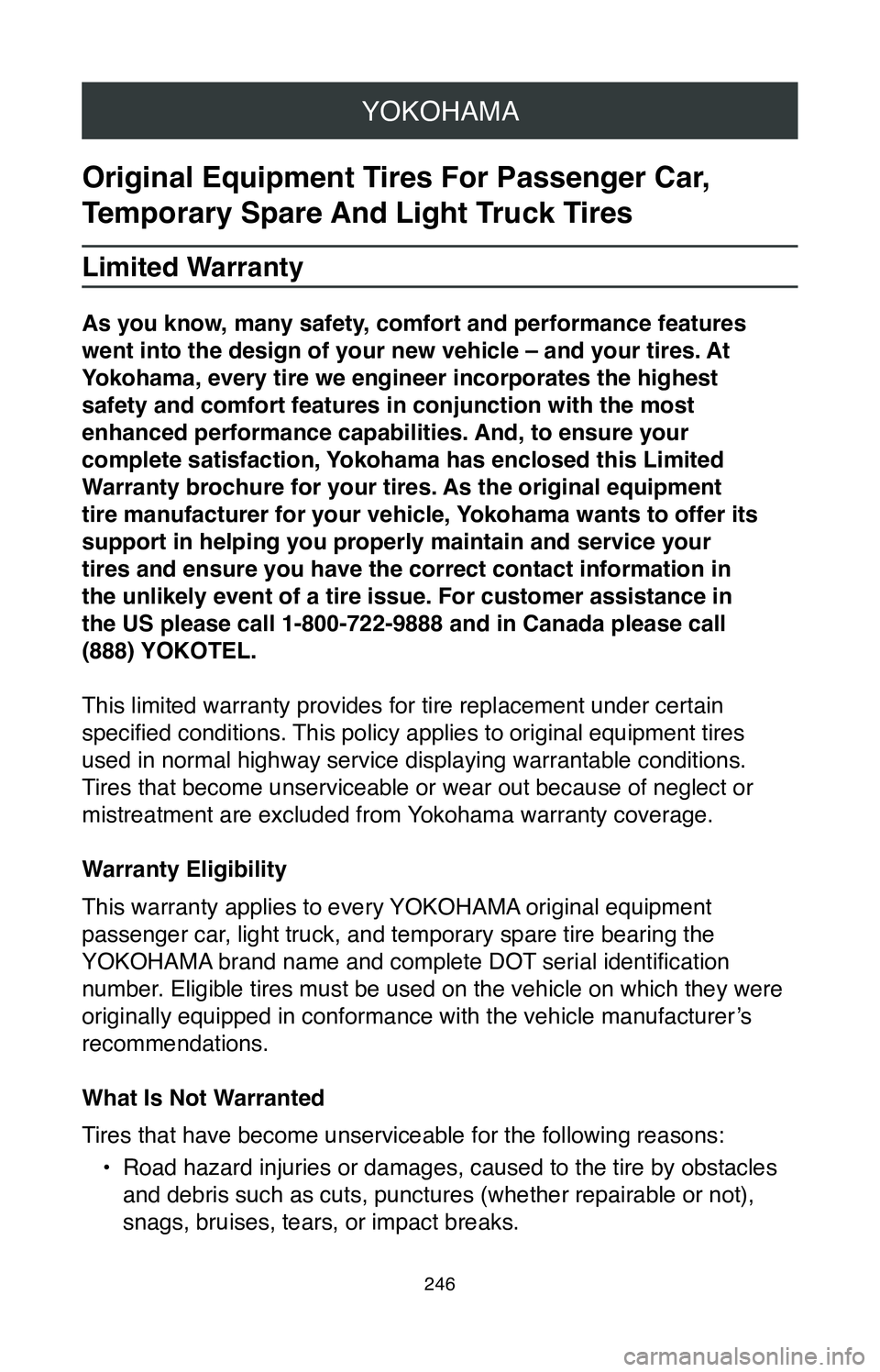
YOKOHAMA
246
Original Equipment Tires For Passenger Car,
Temporary Spare And Light Truck Tires
Limited Warranty
As you know, many safety, comfort and performance features
went into the design of your new vehicle – and your tires. At
Yokohama, every tire we engineer incorporates the highest
safety and comfort features in conjunction with the most
enhanced performance capabilities. And, to ensure your
complete satisfaction, Yokohama has enclosed this Limited
Warranty brochure for your tires. As the original equipment
tire manufacturer for your vehicle, Yokohama wants to offer its
support in helping you properly maintain and service your
tires and ensure you have the correct contact information in
the unlikely event of a tire issue. For customer assistance in
the US please call 1-800-722-9888 and in Canada please call
(888) YOKOTEL.
This limited warranty provides for tire replacement under certain
specified conditions. This policy applies to original equipment tires
used in normal highway service displaying warrantable conditions.
Tires that become unserviceable or wear out because of neglect or
mistreatment are excluded from Yokohama warranty coverage.
Warranty Eligibility
This warranty applies to every YOKOHAMA original equipment
passenger car, light truck, and temporary spare tire bearing the
YOKOHAMA brand name and complete DOT serial identification
number. Eligible tires must be used on the vehicle on which they were
originally equipped in conformance with the vehicle manufacturer ’s
recommendations.
What Is Not Warranted
Tires that have become unserviceable for the following reasons:
•
Road hazard injuries or damages, caused to the tire by obstacles
and debris such as cuts, punctures (whether repairable or not),
snags, bruises, tears, or impact breaks.